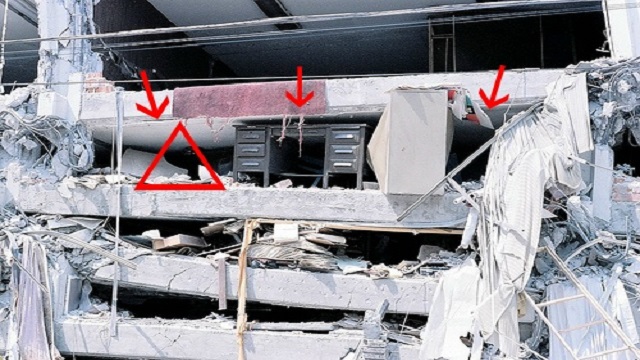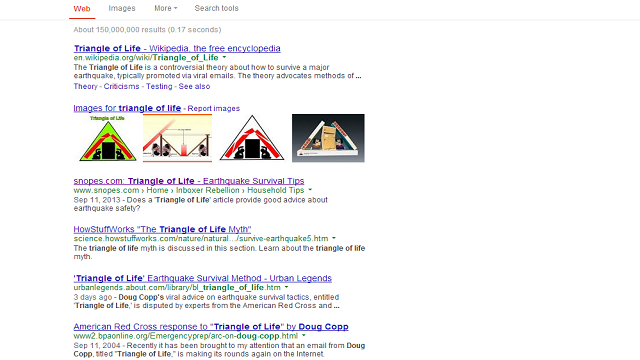SUMMARY
This is AI generated summarization, which may have errors. For context, always refer to the full article.

MANILA, Philippines – Since the 7.2-magnitude earthquake in Central Visayas on October 15, links on earthquake safety and general disaster preparedness have been making the rounds on social media. This is well and good for the most part; because spreading information is key to preventing future harm, and social media has been a boon in this regard.
Nonetheless, the wrong information can ruin all the good that’s been done thus far. Case in point: the ‘Triangle of Life.’
Written by self-professed ‘rescue expert’ Doug Copp, the ‘Triangle of Life’ is an article claiming that hiding under a sturdy piece of furniture during earthquakes – an act recommended by the American Red Cross and other well-known disaster relief organizations – is wrong. Instead, it insists that you should hide next to sturdy objects, not under them. According to Copp’s piece:
“Simply stated, when buildings collapse, the weight of the ceilings falling upon the objects or furniture inside crushes these objects, leaving a space or void next to them – NOT under them. This space is what I call the ‘triangle of life’. The larger the object, the stronger, the less it will compact. The less the object compacts, the larger the void, the greater the probability that the person who is using this void for safety will not be injured. The next time you watch collapsed buildings, on television, count the ‘triangles’ you see formed. They are everywhere. It is the most common shape, you will see, in a collapsed building.”
Odds are that you’ve seen this article, or blog posts referring to this article, in your own social media circles. There’s a chance you may have passed it around yourself. The problem is, doing just a little digging online already unearths a lot of articles highly critical of Copp’s piece.

Google ‘Triangle of Life’ and many entries that show up are articles refuting it, including a statement from the American Red Cross. The other articles are from sites such as trusted hoax-buster snopes.com, and urbanlegends.about.com. They state that Copp’s ideas don’t hold much water because:
1. His experiences are limited to a few countries (e.g. Turkey and Mexico), and since building codes differ with each country, the ‘Triangle of Life’ can’t be universally applied.
2. Moreover, his experiences were mainly based not on an actual disaster, but on a rescue exercise after an earthquake simulation.
3. Worse, Copp’s claim that he was a ‘rescue guru,’ especially during the aftermath of 9/11, is also heavily challenged. He was not authorized to do anything, and was even placed under investigation by the US Department of Justice’s fraud unit.
The ‘Triangle of Life,’ then, isn’t exactly glowing with legitimacy.
In the end, there’s a big difference between instantly sharing whatever comes your way on social media, and checking things first for validity. If a cursory check of the link you want to share already leads to refutations or questions about its credibility, just leave it alone. Better yet, inform the friend you got the link from of what you found. Always stick to information from sources with trusted, credible histories, and not just from random people’s blogs or Facebook statuses.
In a realm as prone to misinformation as the Internet, and specifically in communities as devoid of restraint as Facebook and Twitter, it’s important to form opinions only after some thought and a bit of research. This is especially important if the links you want to share are on matters of life and death. You may think you’re helping but could be doing the complete opposite instead.
If you want to help save lives, then think before you click. – Rappler.com
Add a comment
How does this make you feel?
There are no comments yet. Add your comment to start the conversation.